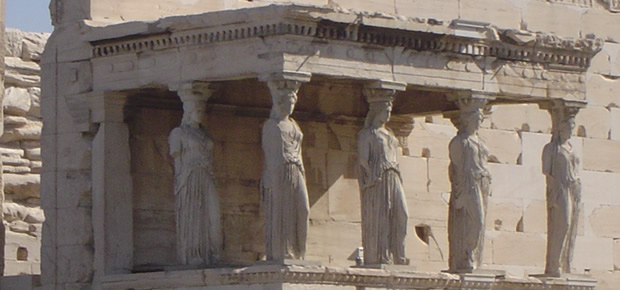
1.12 The figurative arts
In ancient Greece, despite the many local varieties, there was a remarkable uniformity of taste and needs, more changeable over time and space. This is attested in various ways, the rapid spread of the Doric temple throughout the peninsula and in Western Greece; the ease with which the most eminent architects and sculptors moved; or, in the private sphere, dominant position in the prestigious Athenian painted pottery preserved in the world for two centuries and more greek. It must be said that a classic greek, wherever he went, was in a relatively familiar. Classical Greece was a world almost devoid of palaces and forts private. In recent years, they discovered the island of Delos luxurious two-storey houses, richly decorated, built for the merchants italioti that you were in the second century BC, after Rome had conquered the eastern Mediterranean and turned the island into a center of maritime trade. The island of Delos had long been a great Panhellenic sanctuary, full of statues and temples, but he had to wait for the arrival of the Romans to see rise private dwellings so beautiful. L’architettura greca, Along with painting and sculpture, were considered public arts. Among the public buildings, the temple and the theater, which were connected with the worship, eclipsed all other. The Greeks also lavished much care not to buildings dedicated to religion, as indeed were for small objects like coins, but their scale of values, the temple rose up above the other buildings, rose up as the great statues of Athena or Zeus above all other sculptures. Therefore, the state was almost the only patron of the arts monumental. And given the nature of the police classical, Buyers were not individual rulers (except in the west where the tyrants emerged), commissions or professional fine arts, but it was the community acting through the usual tools of democracy: the ASSEMBLY, advice, the magistrates. The art was widespread and present in everyday life, not reserved for leisure or pleasure of wealthy collectors and aesthetes. The art was in the temples, in theaters, porches and cemeteries, not in museums. Also in the house were beautiful coins and beautiful vases and bowls, jars for cosmetics, mirrors and jewelry, terracotta dolls for children. Those who could not afford the finest hand-painted ceramics, contented themselves with common objects and cheap. The number and size of the temples of course depended on the economic possibilities of the entire community. The excellent artistic level, in general, depended not only on the great skill of the artisans, although this was an indispensable aspect of production; it was achieved without an aesthetic theory developed, which became established only later, and was the work of philosophers rather than artists. Long before Plato, perhaps even before Pythagoras, spread the art of the idea that the number was the key to harmony. Thus the Doric temple is made of carefully studied proportions, often simple, such as that between the height of the columns and the spaces between their axes. Rules proportions were also in sculpture, between the parts of the human body. Even the pottery had various forms on its behalf. From these general concepts and rules from which they sprang, emerged well-defined types of temples, of male figures or amphorae.
Fra i Greci, maximally was the philosopher who sometimes reserved the part of the eccentric or rebellious, non artist. He expressed the values accepted by the society in which he lived: if not it away or fighting against them.
If you look at the big archaic sculptures depicting male nudes, known as kouroi, the oldest betray the inspiration of Egyptian art, but in less than a century the Greek sculptors had them perfected to a point that in two thousand years the Egyptians had never reached. The Greek sculptors, potters and painters were soon used to "sign" their work and it was a revolutionary step in the history of art. They were individual artists but not individualists. They accepted and the fees structure for eplorare deeply and freely their chances, testing their skills in every detail, their imagination and their creativity. It can be shown that none of the main lines in the Parthenon is absolutely straight, while the spacings are not equal. So Ictinus created the greatest of all Doric temples. The original and radical deviations were rare. A prominent example is the Erechtheion, with caryatids dressed with peplum, similarity to and remembrance of the women in the city of Caria taken prisoner and dragged slaves in Athens, for further punishment, as told by Vitruvius in De Architectura, were forced to wear the peplum daily, symbol of nobility, even in their state of slavery.




